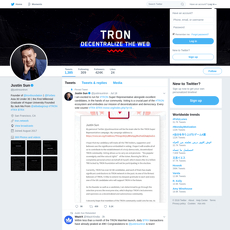Erik Voorhees Review
Erik Voorhees
twitter.com
Erik Voorhees Review Guide: Everything You Need to Know + FAQ
Should you follow @ErikVoorhees on X/Twitter for real crypto insight, or will it just clog your feed with more shouting?
I’ve been watching his posts and presence for years. In this guide on Cryptolinks.com, I’ll show you exactly what you’ll get from his feed, what to watch out for, and how to use his content to actually make smarter decisions in crypto—without wasting hours every week.
You’ll quickly see where his signal shines (Bitcoin, DeFi, regulation, self-custody), where bias might creep in (ShapeShift/FOX, libertarian framing), and how to filter for the good stuff.
The problem: Crypto Twitter is loud, tribal, and often wrong
Twitter/X is the town square for crypto—but it’s also a firehose of hot takes, hindsight bias, and tribal dunking. The challenge isn’t finding opinions; it’s filtering signal from hype, political posturing, and paid promotions.
- Credibility is murky: It’s tough to tell who’s educating vs. shilling.
- Time sinks are everywhere: Thread after thread, little you can actually use.
- Bad info spreads fast: A Science study (MIT) found false news travels farther and faster than the truth on Twitter.
- Outrage outperforms nuance: Research in Nature Human Behaviour shows moral outrage boosts engagement—great for clicks, bad for clarity.
So when you follow someone like Erik, the real question isn’t “Is he famous?” It’s “Does his feed raise your signal-to-noise ratio or tank it?”
My promise: a practical way to use his feed (without the time suck)
I’ll break down who he is, what he actually posts, and the value you’ll get—along with the blind spots that matter. You’ll also get a simple strategy to follow him smartly, not obsessively. By the end, you’ll know if his feed fits your goals—and how to extract the most value with minimal effort.
Who this guide is for
- Curious beginners who want understandable, principles-first crypto content (not meme wars).
- Active traders who want macro and regulatory context to frame risk, not just tickers and TA.
- Builders who care about self-custody, open finance, and consistent thinking on policy and privacy.
How I reviewed his account
I didn’t just skim a few recent posts. I researched:
- Posting patterns: When he weighs in and what he ignores.
- Standout threads: Policy explainers, self-custody arguments, and DeFi vs. CeFi debates.
- Past calls: Where principles aged well (custody risk, regulatory overreach) and where timing didn’t matter.
- Education vs. arguments: How often he teaches vs. fights.
- Skin in the game: Ties to ShapeShift/FOX and where that may color the takes.
Quick example of the kind of signal you’ll see: During exchange blow-ups, he consistently hammered self-custody and counterparty risk—not with memes, but with reasoned threads that aged well as facts emerged.
What you’ll learn in this guide
- Core themes you’ll see again and again (Bitcoin as sound money, DeFi over CeFi, anti-surveillance, self-custody).
- Strengths (principled clarity, policy literacy, long-cycle thinking) and weak spots (libertarian lens, project ties).
- Best posts to watch for and how to filter with Lists, Alerts, and smart bookmarking.
- FAQ answers to the questions people actually ask about him, so you can decide faster if he’s worth your follow.
If you’ve ever wondered, “Why do so many builders and policy folks engage with him—and is that useful for me?” then you’re in the right place.
Ready to see who Erik Voorhees is and why his Twitter actually matters in crypto? That’s next—curious what makes his voice different from the usual market-noise accounts?
Who Erik Voorhees is and why his Twitter matters in crypto
Short background
Erik Voorhees is one of the earliest public Bitcoin advocates and a founder who actually shipped product during multiple cycles. He helped bring Bitcoin into the spotlight with early projects like SatoshiDice and Coinapult, then founded ShapeShift in 2014 to make asset swaps non-custodial and fast. Years later—after hard lessons across the industry—he pushed ShapeShift to become open-source and community-owned, aligning it with self-custody and permissionless access via the FOX token and DAO model.
His public stance has been the same theme for a decade: money should be sound, finance should be open, and users should hold their own keys. He’s a loud, articulate advocate for privacy, self-custody, and the right to transact without gatekeepers.
“Not your keys, not your coins.”
What makes his voice useful
Plenty of crypto accounts shout. Erik tends to reason. That’s valuable—especially when policy, rights, and risk collide.
- Principled consistency: He’s been beating the same drum through bull and bear: Bitcoin as sound money, DeFi over CeFi, and the dangers of surveillance finance. When exchange blow-ups hit (think FTX), his feed didn’t pivot—he simply re-emphasized first principles: custody risk is real, regulatory overreach is a slippery slope, and open systems are resilient.
- Clear explanations for complex topics: Whether it’s KYC/AML trade-offs, why CBDCs worry privacy advocates, or how incentives in CeFi create hidden risk, he explains in plain English without losing nuance.
- Battle-tested perspective: He has lived through multiple market cycles, regulatory waves, and business pivots. That context shows up in his posts and debates. A standout example: his widely watched debate with Sam Bankman-Fried in late 2022 on crypto regulation, where he argued a permissioned perimeter would gut the point of open finance. Many in the industry referenced that moment as a clear line in the sand.
- Policy literacy with receipts: When he critiques CBDCs and mass-surveillance rails, he isn’t alone—central bank research admits the trade-offs. The BIS and ECB have both noted the tension between privacy and compliance in CBDC design, reinforcing concerns he’s raised for years.
Why does that matter to your feed? Because when headlines hit—sanctions on privacy tools, new KYC proposals, or banking choke points—his posts help you separate “this feels bad” from “here’s the principle and the likely outcome.”
What his account is not
If you’re following @ErikVoorhees expecting hourly trade setups, you’ll be disappointed. Here’s what you shouldn’t expect:
- Not a signals feed: He doesn’t post entry/exit calls or scalp charts.
- Not meme-driven: You’ll get some humor, but the core is policy, principles, and product philosophy.
- Not an altcoin hype machine: He rarely chases microcaps or trend-of-the-week narratives.
- Not engagement farming: He tends to post when there’s substance—major policy moves, self-custody teachable moments, or debates worth having.
Where his bias may show
Every strong voice has a lens. Knowing it helps you read smart.
- Self-custody first: Expect him to favor solutions where users hold keys and intermediaries are minimized. After 2022’s centralized failures, that stance will feel persuasive—just remember it can underweight UX or mainstream adoption hurdles.
- Anti-KYC overreach: He pushes back on blanket surveillance and “financial permissions.” This aligns with privacy research and civil liberties groups who warn about mass data collection, but it can clash with policymakers’ risk-reduction goals.
- Ties to ShapeShift/FOX: He has skin in the game. When he talks about non-custodial architecture and open-source rails, it’s both principle and product direction. He’s generally transparent, but you should still clock the incentive alignment.
- Libertarian framing: His worldview emphasizes personal freedom and limited gatekeeping. It’s a coherent compass, but if you prefer a purely neutral tone, you may find the framing strong at times.
I like that the bias is declared through action: turning a centralized company into a DAO, arguing code should remain speech in the Tornado Cash era, and engaging regulators publicly rather than sniping from the sidelines. It doesn’t make him “right” on everything, but it makes the perspective legible and testable.
If that sounds like the kind of signal you want on your timeline, the next question is simple: what does following him actually look like—day to day, post by post, in your feed? In the next section, I’ll show the exact themes, formats, and moments that make or break the follow. Ready to see what you’ll really get from @ErikVoorhees?
What you actually get from following @ErikVoorhees
Core themes you’ll see often
When I scroll Erik’s feed, the signal is remarkably consistent. You’ll see the same pillars appear, not as slogans, but backed by first-principles reasoning and real-world news.
- Bitcoin as sound money: He frames BTC as a check on monetary overreach and the erosion of savings. Expect clear, repeatable arguments about monetary policy, scarcity, and why inflation isn’t just an economic metric—it’s a personal freedom issue.
- DeFi > CeFi (for transparency): After every centralized blow-up, he emphasizes that code and public ledgers reduce opaque counterparty risk. It’s not that DeFi is perfect—it’s that bad risk is visible. For context, Chainalysis reported a record $3.8B stolen from DeFi protocols in 2022, yet the worst bankruptcies (Mt. Gox, Celsius, FTX) were centralized. Erik’s take: opaque risk is worse than visible risk because you can’t price what you can’t see.
- Self-custody, always: His posts return to the basics—hardware wallets, multisig, and personal responsibility. After the FTX collapse, on-chain analytics firms noted historic BTC outflows from exchanges as people moved coins to their own wallets. That aligns with his drumbeat.
- Anti-surveillance, skepticism of CBDCs: He argues CBDCs can turn money into a programmable permission system. You’ll see threads that read more like civics lessons than market takes—how financial privacy ties directly to speech and association.
- Regulatory overreach vs. open finance: He’s articulate on policy, often unpacking what a proposal really means for builders and users. You’ll see him contextualize headlines (sanctions, AML rules, broker definitions) in plain English.
“Not your keys, not your coins.”
It’s a mantra for a reason. And he repeats it not for engagement, but because too many people learn it only after funds are frozen or gone.
Content style
Erik doesn’t flood the feed with memes or price calls. His cadence is thoughtful, and when he cares, you’ll notice:
- Threads with backbone: Expect well-structured threads on why self-custody matters, why CBDC design choices are not neutral, and why DeFi’s transparency is a feature, not a bug. They read like mini-essays, not hot takes.
- Policy critiques that teach: He’ll dissect a proposed rule, then map consequences for users, exchanges, and protocols. It’s educational even if you disagree.
- Debates that draw builders and policymakers: He engages in good-faith back-and-forth with founders, researchers, and policy folks. His famous 2022 regulation debate with SBF is a good reference point for how he makes the “freedom tech” case under pressure.
- Occasional project updates: You’ll see mentions related to open-source and DAO efforts around self-custody tooling—never the majority of his feed, but present enough that you know where he’s building.
Signal-to-noise
I don’t follow Erik for daily dopamine hits—I follow him for posts that hold up months later. The ratio is solid:
- Original thought > retweets: He amplifies others, but the value is in his own framing and reply threads where he tests ideas with smart critics.
- Quality over quantity: He tends to weigh in when something actually matters—major policy moves, exchange failures, real DeFi progress—instead of posting filler all day.
- Time-saving: If you’re filtering Crypto Twitter for clarity, his feed cuts down on scroll fatigue. It’s more “read this once, remember it later” than “refresh every 20 minutes.”
Who benefits most
Following @ErikVoorhees is especially useful if you want:
- Big-picture direction: Builders and investors who care about the “why” behind crypto—monetary freedom, open rails, censorship resistance.
- Regulatory context without legalese: Traders and founders who need to understand the impact of new rules on liquidity, custody, and product design.
- Practical self-custody reminders: Beginners who’ve used exchanges for years and need a push to secure assets properly.
Potential downsides
Strong viewpoints are valuable—and polarizing. Here’s what to watch for so you read him smartly:
- Ideology first, not market-neutral: His libertarian lens is clear. If you want purely neutral tone, you might find parts of the feed intense.
- Less emphasis on alt microcaps or day-trade setups: If you mainly want entry/exit signals, this isn’t that. He’s about structure and principles, not scalps.
- DeFi risks can feel “priced in” to his worldview: While he acknowledges hacks, his emphasis on transparency may underweight how complex DeFi risk really is. For context, Chainalysis tallied billions lost to DeFi exploits in 2022—use his arguments to frame the trade-offs, then layer in security research for the implementation details.
He posts like someone building for a decade from now. That’s refreshing when the timeline is full of bait and FOMO. But does this long-term clarity match a solid track record when the pressure hits—exchange failures, policy shocks, and bear markets? That’s exactly what I’ll look at next.
Credibility check: track record, notable moments, and accuracy
When I judge whether an account is worth my attention, I look for receipts. With @ErikVoorhees, there’s a long paper trail of principled calls, public debates, and decisions under pressure. Here’s what the record actually shows.
Quick timeline at a glance
- Early Bitcoin years: Among the earliest public advocates pushing the “money without permission” narrative when it was deeply unpopular.
- ShapeShift era: Builds one of the first fast, non-custodial crypto swap services. No accounts, no custody—then the regulatory vise tightens.
- KYC battles (2018): Under regulatory pressure, ShapeShift adds KYC—he openly admits it goes against his ethos and explains the tradeoff publicly.
- Open-source pivot (2021): ShapeShift sunsets its corporate custody model, open-sources the code, and transitions to a DAO with the FOX token, aligning business incentives with self-custody.
- CeFi implosions (2022): As Celsius, Voyager, BlockFi, and FTX collapse, he hammers the same message he’d been repeating for years: hold your own keys and favor transparent systems.
“Custody is the product. If you outsource it, you outsource the point.”
Notable moments that shaped his credibility
- Public debate with Sam Bankman-Fried (Oct 2022): On the Bankless show, he challenged SBF’s push to regulate DeFi front-ends. Weeks later, FTX collapsed, and Voorhees’ thesis—CeFi opacity is the real systemic risk—looked painfully prescient. Watch it here: Bankless debate.
- Self-custody after FTX: He urged users to withdraw from exchanges long before it was trendy. After FTX, users did exactly that—on-chain data showed record outflows from centralized exchanges as people moved to wallets. See coverage: CoinDesk: record outflows.
- On KYC/AML overreach: He’s consistently argued that blanket surveillance harms privacy while barely touching illicit finance. Independent figures back up the skepticism: the UN estimates the global system recovers less than 1% of criminal funds despite massive compliance costs. Source: UNODC.
- OFAC vs. Tornado Cash (2022): He was vocal that sanctioning open-source code is a slippery slope. Whether you agreed or not, he framed the constitutional questions clearly, and regulators/judges are still wrestling with where to draw the line.
- ShapeShift transparency moves: Even when forced into KYC in 2018, he wrote plainly about why and later reversed course with the DAO model—rare corporate-to-DAO pivot that aligned with the values he’d been preaching.
Calls that aged well vs. not
- Aged well: structural risk of centralized custodians. From Mt. Gox to FTX, he kept warning that black-box balance sheets blow up portfolios. The 2022 cycle proved the point in brutal HD. If you listened, you avoided the worst.
- Aged well: skepticism of “regulate the front-end” for DeFi. The SBF plan would’ve kneecapped open finance UX while leaving opaque custodians untouched. The FTX fallout flipped the Overton window; today, better-targeted approaches are on the table.
- Aged well: CBDC caution. He’s argued CBDCs centralize control and risk civil liberties. In the U.S., political resistance has grown, and pilots face mounting pushback. The direction of travel matches his warnings.
- Not his game: short-term price targets. If you want timestamps on tops and bottoms, this isn’t it. His “accuracy” lives in principles, not scalps.
Conflicts and disclosures that matter
- ShapeShift/FOX exposure: He’s tied to the ecosystem he helped create. When he talks about self-custody and open-source wallets, principle and incentive meet. That doesn’t invalidate the message—but it’s context you should keep in the back of your mind.
- Libertarian framing: Expect a strong bias toward freedom-tech, privacy, and minimal gatekeepers. If your mental model is “compliance-first,” you’ll often disagree. The value is in understanding a coherent, opposing lens.
How I sanity-check his threads before I act
- Primary sources or it didn’t happen: I look for links to bills, agency posts (SEC, CFTC, OFAC), audits, GitHub repos, or on-chain data. No links? I pause.
- Cross-fire comparison: I compare his take against credible critics—policy analysts, security researchers, and builders who disagree. If the counterarguments are weak or ad hominem, that’s a bullish signal on his point.
- Data backstops: For market claims, I check dashboards (Glassnode, Dune, DeFiLlama) or reporting from outlets with a data spine (e.g., CoinDesk’s on-chain coverage). For policy efficacy, I lean on neutral stats (UNODC, BIS research).
- Time consistency: I note whether he’s saying the same thing when it’s unpopular. His self-custody stance didn’t show up after FTX—it’s been steady for years. Consistency > retrofitted victory laps.
Net-net, the record shows a thinker who wins on first principles: custody risk, open systems over black boxes, privacy as a feature, and an allergy to performative policy. That’s the kind of “accuracy” that keeps you solvent.
Okay, so you trust the signal—now how do you actually use it without letting Twitter hijack your day? Want the exact setup I use to catch the good stuff and skip the noise? Let’s get tactical next.
Pro tips to get the most value from his feed
Start with “best-of” threads
I start by hunting for the posts that anchor his worldview—then I keep them handy as reference points when the next policy fight or exchange blow-up hits.
- Check his profile for pinned threads and long-form explainers. Look for themes like self-custody, CBDCs, DeFi vs. CeFi, and principled takes on policy.
- Use targeted searches to surface the gold:
- from:ErikVoorhees self-custody
- from:ErikVoorhees CBDC
- from:ErikVoorhees DeFi CeFi
- from:ErikVoorhees FTX
- Bookmark canonical moments for re-reading when sentiment swings:
- The policy clash with SBF on DeFi regulation (Bankless debate; search “Voorhees SBF Bankless” on YouTube or X)
- His “CeFi risk vs. DeFi transparency” commentary during exchange failures
- Threads warning about CBDCs and financial surveillance risk
“Signal beats speed: curate, verify, then act.”
Why this works: attention is scarce. Research shows context switching erodes judgment—see Stanford’s classic study on multitasking and focus (Stanford, 2009). A short “best-of” library gives you a compass when the feed gets loud.
Use Lists and Alerts
I keep him on a high-signal lane so I only get pinged when it’s likely meaningful.
- Create a focused List: “Policy & Principles.” Add @ErikVoorhees and a few counterpoints (more below). This isolates thoughtful posts from the noise of your main feed.
- Turn on notifications strategically: Only for major policy days (hearings, executive orders, big enforcement actions) or market shocks. Toggle the bell on his profile when you expect signal.
- Use Bookmarks: Save his threads that include primary sources (bills, audits, research). Create a habit: when news breaks, re-check those bookmarks for context.
- Power user tip: In X Pro (TweetDeck), make a column for:
- “from:ErikVoorhees (min_retweets:50 OR filter:links)” to surface higher-signal posts
- “to:ErikVoorhees filter:replies” to catch substantive pushback in his mentions
UX research consistently shows that chunking and segmentation improve comprehension and decision-making. Lists and columns are your “chunking” tools (Nielsen Norman Group).
Balance the lens
He argues from principled, pro-freedom ground—use that as one pillar, then triangulate with practitioners and skeptics so you don’t get trapped in an echo chamber.
- Policy and law:
- @jchervinsky (policy analysis)
- @HesterPeirce (regulatory perspective)
- @coincenter (civil liberties + crypto policy)
- Security and audits:
- @samczsun
- @OpenZeppelin
- @trailofbits
- Builders and researchers:
- @VitalikButerin
- @neha (MIT DCI)
- @chainalysis (data lens)
- Critical voices:
- @molly0xFFF
- @BennettTomlin
Pew Research has shown how social feeds shape perceptions of news and risk; intentional diversity in sources is a simple way to boost signal quality (Pew, social media & news).
Engage smartly
I don’t read his posts in isolation—I scan the replies for credible counter-arguments and sources.
- Look for “builder rebuttals”: When he critiques KYC or CBDCs, check replies from policy analysts or auditors. Save threads where experts add links to bills, audits, or incident reports.
- Ask clarifying questions: He engages in good-faith debates. Short, specific questions (“Do you see any scenario where CBDC privacy could be guaranteed at L2?”) get better answers than open-ended takes.
- Use the “source test”: Before you retweet, ask: Does this include primary links (bill text, repo, whitepaper, audit)? If not, wait.
- Tag your “context buddy”: Loop in a security or policy account when a thread is technical or legal. You’ll crowdsource review in public.
Know when to scroll on
There’s a difference between principled argument and tribal drama. I use three quick filters to keep my blood pressure (and PnL) in check:
- Link test: No primary sources? Keep scrolling.
- Time-horizon test: Is this about a month, or a decade? He’s strongest on long-horizon principles. If the thread is devolving into minute-by-minute scorekeeping, skip it.
- Incentive test: If a post touches anything adjacent to ShapeShift/FOX, I assume bias and seek two outside confirmations before acting.
Emotional spikes are your enemy. Studies on information overload show that high-volume, reactive browsing degrades decision quality—calm, curated sessions win in the long run (Stanford).
Want the fast answers to the most common questions about his stance, posting style, and whether he’s a Bitcoin-only guy or multi-chain? I’ve pulled together a tight FAQ with exactly that—ready to check it out next?
FAQ: quick answers to what people also ask
Who is Erik Voorhees and why do people follow him?
He’s one of the earliest public Bitcoin advocates and the founder behind ShapeShift. People follow him because he consistently explains crypto’s purpose—self-custody, open finance, financial privacy—in plain English and with a long memory of what’s worked and what’s failed. When centralized exchanges blew up in 2022, his posts hammered home the self-custody lesson with practical clarity instead of “told you so” fluff. If you want principles-first context rather than hype, his feed delivers.
Is he a Bitcoin maxi or multi-chain?
Think “Bitcoin-first, multi-chain open-minded.” He’s crystal clear on Bitcoin as sound money, but he actively engages with DeFi ideas, Ethereum ecosystem builders, and cross-chain tooling. You’ll see him argue that DeFi’s design—transparent, auditable, non-custodial—matters more than brand loyalty. If you’re looking for microcap shills or chain wars, you won’t find that here.
What is ShapeShift and how is he involved today?
ShapeShift began as a non-custodial way to swap crypto without giving up control of your keys. After years of regulatory pressure (including a period that required KYC), the project shifted toward an open-source stack and a DAO structure in 2021. Today, he’s best described as a public voice and contributor aligned with the community (and the FOX token), not a traditional CEO. Expect occasional updates, but his feed is bigger than any one project.
Does he post trading calls?
No. He doesn’t do “buy this at 12:03 PM” content. You’ll get macro theses, policy analysis, and strong takes on structure (custody, transparency, decentralization) instead of short-term signals. If you want scalp-ready entries, this isn’t your guy. If you want to understand why self-custody risk is different from exchange risk, that’s exactly his lane.
How often does he post and what’s the tone?
Expect a few thoughtful posts per week, with spikes during policy fights, major hacks, or market stress. The tone is principled and respectful, occasionally spicy when it comes to surveillance or CBDC pushers. He engages in debates, shares longer threads, and tends to weigh in when it matters rather than blasting your feed hourly.
Has he been involved in controversies or regulatory issues?
Yes—part of why his perspective is grounded in reality. He settled a 2014 SEC case related to unregistered offerings tied to early Bitcoin projects (long before ShapeShift’s DAO era). In 2018, ShapeShift’s move to KYC sparked backlash; years later, the project leaned fully open-source and non-custodial. He’s also been a loud critic of overreaching AML surveillance and the sanctioning of privacy tools. Important context: this is not someone accused of misusing customer funds—his core critique has always been against centralized custody risk.
What are his biggest debates or viral threads?
Standouts include his widely watched debate with Sam Bankman-Fried in 2022 about DeFi regulation (which aged very clearly after FTX’s collapse), and recurring threads on why CBDCs threaten privacy and why self-custody is non-negotiable for resilient markets. He also engages productively with policymakers and builders in replies—those reply chains are often where the sharpest insights live. You can scroll his Twitter/X profile to find pinned or high-engagement threads.
Is he biased? How should I read his posts?
Every credible voice has a lens. His is libertarian and strongly pro-self-custody. He’s also economically aligned with ShapeShift/FOX’s success as an open, non-custodial ecosystem. That doesn’t invalidate the arguments—but it’s smart to read with this in mind. I suggest a simple filter:
- Principle check: Is he arguing from self-custody, openness, and user sovereignty?
- Incentive check: Could this post indirectly benefit ShapeShift/FOX?
- Evidence check: Are there data points, code references, or credible sources you can verify?
Balance principles with proofs. When the two line up, you’ve likely found signal.
Is his content beginner-friendly?
Mostly, yes. His “why crypto matters” posts read well for newcomers, and he avoids arcane jargon when talking about custody and policy. Some DeFi and privacy threads assume basic familiarity. My tip: bookmark his explainers on self-custody, CBDCs, and DeFi vs. CeFi and re-read them when news breaks—they double as a field guide when the market gets noisy.
Who else should I follow alongside him for balance?
- Policy and legal: Hester Peirce (SEC), Jake Chervinsky, Jerry Brito/Coin Center
- Security and engineering: samczsun, Trail of Bits, OpenZeppelin
- Builders and researchers: Vitalik Buterin, Hasu, Gauntlet
- Macro and energy: Lyn Alden, Nic Carter
- Critical voices: Molly White, Bennett Tomlin
This blend keeps you grounded across ideals, implementation, and scrutiny—crucial if you want to make smart, independent decisions.
Want my straight-up verdict on whether his feed belongs on your must-follow list—and a simple setup to get the most value in under 10 minutes? That’s exactly what I cover next.
Should you follow Erik Voorhees? Final take and next steps
My verdict
If you care about the “why” of crypto—self-custody, open finance, and the policy battles that shape our future—follow Erik Voorhees. He’s at his best when the stakes are high: exchange failures, new bills, CBDC chatter, or moments when principles are on the line.
Don’t follow him expecting day-trade setups, microcap rotations, or meme cycles. Follow for clarity, consistency, and a north star that doesn’t wobble with the price chart.
“If you don’t control the keys, you don’t control the money.”
That refrain isn’t just rhetoric. During blow-ups like FTX (2022) and banking jitters (March 2023), his message stayed the same: take custody, reduce counterparty risk, and understand what permissionless systems protect you from. His public debate with Sam Bankman-Fried on DeFi regulation—before everything unraveled—aged like granite: permissionless ≠ lawless, and centralization invites failure.
It also matches what research keeps finding: attention and sentiment matter in crypto, but they matter most when tied to credible sources and real signals. A well-cited study by Liu and Tsyvinski (Yale, 2018) showed investor attention is a meaningful predictor for crypto returns. Earlier work by Bollen et al. (2011) found Twitter sentiment could anticipate market moves in traditional finance. The takeaway for you and me: quality inputs beat noise, and Erik is a quality input—especially on principles and structure.
Best way to start
- Skim the pinned and longer threads. Look for posts on self-custody, CBDCs, and the purpose of crypto. Those are his highest-signal pieces.
- Create a “Policy & Principles” List and add him to it. When the news cycle gets crazy, scan this list first.
- Turn on notifications selectively. I set alerts for “Tweets” (not every reply) during policy weeks, major SEC/ETF headlines, or exchange stress.
- Use X search smartly: type from:ErikVoorhees plus keywords like self-custody, CBDC, or regulation to surface his best takes fast.
- Bookmark threads with data or sources. Revisit them when new events echo old patterns.
- Mute words that waste time. If a spat starts spiraling, I mute the thread and stick to the educational posts.
If you want a broader view
Balance ideals with implementation. Pair Erik’s principles with practitioners who stress-test reality:
- Policy and legal: @jchervinsky, @coincenter, @jerrybrito, @NeerajKA
- Security and audits: @samczsun, @trailofbits, @0xfoobar
- Builders and research: @VitalikButerin, @coinmetrics
This mix keeps you grounded: ideals from Erik, attack surfaces from security folks, and hard data from researchers.
Conclusion and next steps
I follow Erik because, when things get messy, his compass doesn’t. He explains why self-custody matters, why open systems beat gatekeeping, and how policy choices can either unlock innovation or choke it.
If that’s the lens you want—less noise, more purpose—hit follow. Start with his longer threads, add him to a focused List, and set alerts for big policy days and market shocks. Most importantly, build your own filter: reward posts with sources and first-principles reasoning, and scroll past anything that’s just tribal sparring.
I’ll keep this guide on Cryptolinks updated as his content evolves and new debates pop up. If you spot a thread worth adding to the “best-of” list, tag me—I’m always hunting for the strongest signal.
Reminder: nothing here is investment advice. It’s a strategy for curating your feed so you can think more clearly and act with conviction.
CryptoLinks.com does not endorse, promote, or associate with Twitter accounts that offer or imply unrealistic returns through potentially unethical practices. Our mission remains to guide the community toward safe, informed, and ethical participation in the cryptocurrency space. We urge our readers and the wider crypto community to remain vigilant, to conduct thorough research, and to always consider the broader implications of their investment choices.













